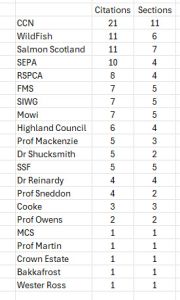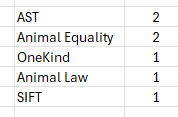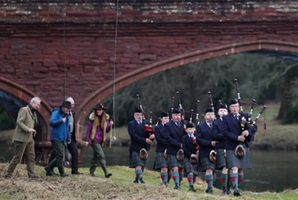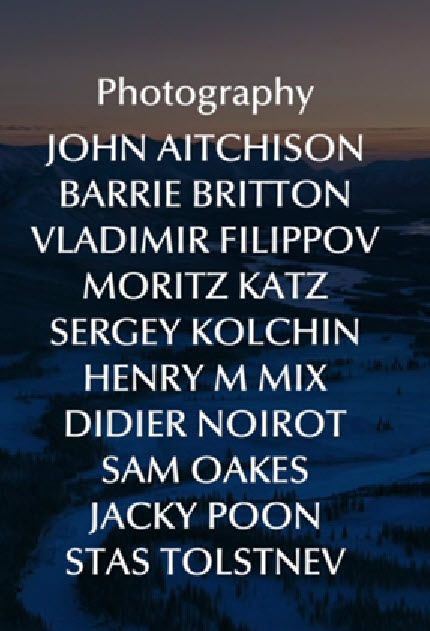Transparency: Fish Farming Expert spoke to the convenor of the Scottish Parliament’s Rural Affairs Committee following the publication of their report about salmon farming. Speaking to the industry he said that ‘Transparency is your friend’. He expanded this to say the ‘the whole industry should be more transparent about what’s actually happening which would lead to less mistrust’. The convenor said that the RAIC’s recommendations are focussed on reducing mortality and reducing the ‘polarisation’ between those who support or oppose salmon farming.
If the RAIC investigation had been more in-depth and more focussed, the Convenor would have realised that it will take more than a few recommendations to reduce the polarisation that is the result of few very vocal opponents who aren’t interested at all whether mortality is high or low. They simply want to see an end to salmon farming for reasons best known to themselves and they see mortality as a vehicle to help them achieve their aims. In around 2018, the then Salmon & Trout Conservation realised that their campaigns to persuade consumers to stop eating farmed salmon weren’t working so instead decided to highlight mortality in the hope that there would be a public outcry against the industry. Not surprisingly, there hasn’t been a public outcry, but the media likes the story, so six years on, the RAIC Committee believe that mortality is an issue that should be addressed. Meanwhile, as the RAIC Committee has discovered, the real issue of why so few wild salmon now survive remains unaddressed.
Returning to the issue of polarisation, as the opponents are only interested in the removal of salmon farms, they are not interested in discussing the issues or seeing them resolved. Thus, holding this inquiry can only be deemed to be somewhat pointless as it has not satisfied the demands of the opponents who want to see the closure of all net pen salmon farms.
The fact that the Convenor has had to admit that there was not even agreement in the committee and two members had demanded a total moratorium on the industry demonstrates the failure of the Committee to drill down and address the issues. Instead, the Committee followed the long-established anti-salmon farming narrative by calling anti-salmon farming opponents as the first two witnesses. Members of the Committee didn’t get to hear from the salmon industry until their sixth meeting and get to visit a salmon farm until late into the inquiry. A more commonsense approach would have been to learn about the industry first and then hear from the opponents. Allowing them to speak first certainly appears to have enabled their message to stick in Members’ minds. An analysis of the responses in the report by all the witnesses, shows the two anti-salmon farming witnesses, dominate the thinking. The two columns in the following table are the number of references to responses and the number of sections of the report to which the responses were addressed.

A second table shows the references to written submissions

It is interesting that the most references come from the two main anti-salmon farming groups. It is even more interesting that they are probably the least competent to speak about salmon farming in terms of either qualifications or experience. John Aitchison of the Coastal Communities Network has made it no secret that he only became interested in salmon farming when plans were proposed to establish a farm near his home. In the report, CCN are quoted as saying that ‘you need thousands of fish counted each week to give a meaningful relatively statistically accurate figure for lice on a farm.’ This is simply untrue. Marine Directorate scientists agreed with the SFCC that a sample size of 30 fish was needed when sampling wild fish (and they only achieved that number in 18% of their samplings). As can be seen from the following graph, over twenty per cent of the samplings caught just one fish. This is a far cry from the thousands of farm salmon that according to Jon Aitchison need to be sampled to get a meaningful result. Perhaps the quality of evidence on which the Committee have based the findings of their report is somewhat flawed. There is a lot of nonsense spoken about salmon farming and it seems that the Committee might not have been able to determine which evidence is accurate and which is not.

Meanwhile, in the report, WildFish questioned the quality of the information published yet they previously published a report that every farm releases 2 billion sea lice larvae every week, yet no-one has ever found levels of sea lice in the sea above one per cubic metre of water. Their science is extremely flawed which is why they avoid any attempt to discuss the science behind their demands to close salmon farms.
In a posting made after the publication of the report, WildFish state that given the weight of historical and new evidence showing the negative impacts of open net salmon farms on wild fish, action is long overdue. Yet again opponents talk about the evidence against the salmon farming industry without actually providing any examples. I would suggest without such evidence, these negative impacts are simply in WildFish’s imagination. I would be happy to discuss these impacts with WildFish but they refuse any contact.
It is also worth remembering that during the panel discussion involving scientists, a number of responses were made in which witnesses were pressed to give an answer whilst admitting that the subject was not their area of experience. This could simply be due to calling witnesses who were qualified to speak on one specific issue only.
Observant readers of reLAKSation may have noted that my own name is not present at all, despite writing three detailed submissions. This was not of any surprise to me since the Committee rejected more than once having me appear in person as a witness.
Having gone through the report, it became apparent that the reason why my submissions were ignored was that the main report does not include any discussion on the impacts of sea lice on wild fish. The section on interactions appears to focus on escapes only and the sea lice risk framework is covered in the section of site location. The absence of any discussion on sea lice impacts on wild fish is symptomatic of the wider refusal to discuss these issues whether it be government scientists, SEPA, the wild fish sector and all opponents. The RAIC Committee is simply following in their footsteps, which is really surprising given that this inquiry is described as a follow-on inquiry, and it was the alleged impacts of sea lice that promoted the original REC inquiry.
Perhaps, if the Committee had actually investigated the interactions in detail, it might have gone some way towards the addressing the issue of polarisation. This polarisation only exists because the opponents refuse to discuss the issues as they don’t want to be shown to be wrong and the claims they make unjustified.
Although the main report doesn’t address the impacts of sea lice, a small section hidden away between the various recommendations’ states:
The Committee understands the concerns expressed by some in evidence that the presence of sea lice around salmon farms could be impacting on wild salmon migratory routes, in particular on smolts.
The Committee acknowledges that there are likely to be a range of factors that have contributed to the decline in wild salmon stocks over recent decades and considers that it is possible sea lice attracted by the presence of salmon farms could be one. However, it also recognises that there is a lack of definitive scientific evidence on this issue.
The Committee welcomes the Scottish Government initiative to set up a working group to look at existing policy and advice governing these issues and to produce recommendations on how interaction between wild and farmed salmon can be taken forward in the future.
The Committee is wrong in saying there is a lack of definitive scientific evidence on sea lice impacts. The evidence was provided in my submission but clearly, they preferred to ignore it to appease the various opponents, some of whom in my opinion had a mouthpiece on the Committee speaking on their behalf. Sadly, the MSP concerned is uninterested in hearing any other view.
I guess we now must wait to see what form of working group the Scottish Government intends to establish to see whether these issues finally get to be discussed. The experience of the Salmon Interactions Working Group, that avoided such discussion because it was considered too contentious does not fill me with confidence. However, as a specialist with many years of working on these issues, I look forward to hearing from the Scottish Government with an invitation to join this group.
Sharp eyed readers may have seen one line in the above part of the report which may have left them somewhat puzzled. Talking about the reasons why wild salmon stocks are in decline, the report states:
The Committee….considers that it is possible sea lice attracted by the presence of salmon farms could be one
This shows a complete lack of understanding of sea lice interactions and illustrates why the issue of sea lice is so contentious. Sea lice are not attracted by the presence of salmon farms.
Meanwhile, point 212 in the main body of the report states
“The Committee is aware of the NASCO-commissioned review of the effect of salmon aquaculture on wild Atlantic salmon populations. The Committee recommends the Scottish Government consider the findings of this review in so far as they relate to the risk posed to wild salmon from sea lice dispersal from farmed sites in Scotland when the review report is published. The Committee also recommends the Scottish Government update the Committee on what, if any, changes it then intends to make to finfish aquaculture policy as a result of the NASCO review findings.”
Having gone through all the meeting reports, and some of the correspondence, I have not seen any reference to NASCO and their review, so it is unclear how the Committee are aware of it. However, as NASCO are effectively a representative organisation for salmon anglers, there review is unlikely to be impartial. Certainly, attempts to enter into discussion with NASCO and the members of their review team have been rebuffed. The one member of the review group is a Scottish Government scientist who has so far shown no interest in discussing any alternative view of science. I repeat my offer to sit down with him to discuss the issues.
Finally, I was also struck by recommendation 40.
“Although there is a lack of definitive scientific evidence of the various factors that are contributing to the decline of wild salmon stocks, the Committee is nevertheless of the view that a precautionary approach should be taken which will seek to minimise the potential risk to wild salmon stocks wherever possible.”
It seems that the Committee are arguing that a precautionary approach (which is based on a lack of scientific evidence) should be applied to all the various factors impacting wild salmon (except where the science is known). The clear inference is that until better evidence showing why wild salmon are in decline becomes available any direct interaction with the fish should cease. Should this picture of the 2025 opening of the River Tay salmon fishing season be the very last?
 (The Times)
(The Times)
Finlay Carson says that transparency should be our friend. I am hoping that RAIC Committee can be a little more transparent about how they arrived at their conclusion. How, they chose the witnesses they called and who decided what they would talk about.
Faded green: Following publication of the RAIC report, one of the Committee members has posted a comment on her party’s webpages. Arianne Burgess MSP of the Green Party has said that they must act now to stop the risks of long-term damage to our marine environment and rural communities. However, like the critics who she prefers to listen to, she has not provided any evidence that salmon farms are harming the marine environment or rural communities. The only issue she highlights is mortality and says that ‘imagine if a quarter of farm cattle were left dead in fields, there would be an uproar about animal rights. Ms Burgess ignores the fact that even the RSPCA told the recent Westminster inquiry that you cannot compare mortality of fish with that of terrestrial farming. In addition, even if there was a massive disease outbreak in traditional agriculture, animals would not be left dead in the fields, nor are fish left dead in the water. There is a whole support network of ‘knackermen’ in terrestrial farming and whether there would be uproar about animal rights is conjecture. Ms Burgess may not be familiar with the outbreak of foot and mouth that ravaged English agriculture. I seem to remember there was a great deal of sympathy for the farmers from the public rather than protests about the thousands of deaths. Of course, there is now a well-funded vegan movement that would no doubt be highly critical if foot and mouth were ever to hit again.
Reading Ms Burgess’s comments does make one wonder whether she ever listens to anyone other than opponents to the sector. She talks about overfarming – a term which is new to me – and that there is evidence that these fish feel distress and pain from their crowded environments. In my experience fish stop feeding as soon as any issues arise which would be a major problem for any farm, yet millions of fish reach market size without issue. Ms Burgess certainly hasn’t registered the fact that the fish take up only 1,5% of the volume of the pens which does not suggest overcrowding in anyway.
I have tried to engage with Ms Burgess in the past to discuss the issues but like other critics, she never responds. As an MSP, I would hope that she would be willing to listen to all sides of the argument but seemingly she is not.
Unsurprisingly, Ms Burgess was one of the MSPs who dissented against the proposal not to introduce a moratorium on salmon farming.
Postscript: As this commentary was written, news broke that one million hens are to be culled at one of the UK’s largest poultry farms following an outbreak of bird flu. IN response, the NFU said that farmers take such care to protect the health and welfare of their birds and its devastating to see that compromised. Seemingly, there is no public outcry and strangely silence from groups like Animal Equality and the Green Britain Foundation.
First words: It is some time since the RAIC inquiry began back on June 5th, 2024, so it’s likely that most observers will have forgotten much of what took place then an in subsequent sessions. It is worth looking at the first question posed by the Convenor.
It has been estimated that salmon farming is worth £760 million to the Scottish economy in 2021, and it provides more than 1500 full time jobs. In your view does salmon farming bring economic and social benefits to Scotland? If so, how could those benefits be improved?
The first to answer that question was Rachel Mulrenan of Wild Fish – the organisation representing the interests of salmon and trout anglers.
Her reply was that in the past 30 years between 1990 and 2020 out of a total of 22,100 new jobs in the region, 465 were in salmon farming representing 2% of the jobs. She added that it comes at a huge cost to the environment.
I am not in a position to say whether her figures are right but 465 jobs over 30 years seems low, and we are talking about an organisation that has put a figure of 2 billion sea lice emitted by every salmon farm every week, yet no sign of these numbers have ever been found in any country farming salmon.
Rachel also says that salmon farming comes at a huge cost to the environment but doesn’t say what this cost is. By comparison, Scottish Government data clearly shows that WildFish members and their associates have over the same thirty years killed 1,150,313 wild salmon and 510,711 wild sea trout for sport. It is not for me to say but I would have thought the loss of 1.6 million wild fish represents a huge cost to the environment.
Rachel added that the Scottish Government have never done an analysis comparing the benefits of salmon farming against the negative impacts but then they have never done the same for angling.
The same question was put to John Aitchison of the Coastal Communities Network who said all jobs are important, but they do not depend on how salmon farming is done. He added that if salmon farming was done better there would be more jobs but doesn’t say how.
Interestingly, whilst Mr Aitchison says that he lives in a coastal community on the west coast, we know from the BBC TV programme ‘Asia’, that he has to travel away from home to find work. Clearly if the CCN should get their way, and salmon farms are closed, then many more workers would have to follow his example and travel away from the area in order to find the type of high paying employment that salmon farms already provide.

The main point arising from this question is what are Rachel and John’s qualifications and experience that would allow them to answer this question other than the desire to rid the west coast of salmon farms.

